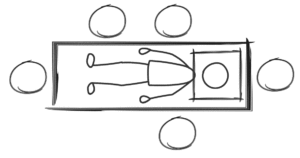
In my last blog, “How to Run a Reiki Share (Part I)“, I spoke about what Reiki shares are and why you might want to organise or attend one, and I ran through lots of practical points like where to hold them, where to find treatment tables, what to bring with you and how it actually works in practice in etrms of working out timings and keeping track of time during the treatment sessions.
Here, I want to talk about: where to stand around the treatment table with different numbers of participants, what hand positions to use, how to finish the treatments, using intuitively-guided hand positions at shares, giving and receiving attunements and empowerments, and what other things people get up to at Reiki shares!
Where should people stand, around the treatment table?
This is not set in stone, but here are some useful combinations for different numbers of participants:
Three people



Four people




Five people



Six people



Seven people

What hand positions should you use?
You can be really flexible with hand positions. They are not set in stone, and the person is going to be receiving Reiki that is channelled into them from lots of different places, so it does not really matter: it will be a wonderful experience for the recipient no matter where people put their hands!
If you’re sitting at the head of the table, it would be nice to start by resting your hands on the shoulders for a few minutes. Then you can use any of the hand positions that you already know; perhaps you will decide to cradle their head on your hands or perhaps you will decide to not disturb them, and stay off the body for the rest of the treatment.
If you are standing by the torso, you could rest one hand on the solar plexus and hover the other hand over the heart area (when treating a woman) or rest your hand on the heart area (when treating a man); all hand positions should be non-intrusive, of course. You could then move on to treat both side of the abdomen (hands at the level of the navel) and treat both hips; you are constrained by the presence of other people giving the treatment, though, so if two of you are treating the torso, perhaps you could stay to your side, treating the abdomen and hip on your side of the body, perhaps while they do the same on the other side. It can be powerful to mirror hand positions on either side of the midline.
Of course, if you are the only person standing on your side of the treatment table, you can range all the way along, almost from their shoulders to their ankles.
One area of the body that tends to get neglected during routine Reiki treatments is the arm, or the hand, and if you are standing by the torso then you could rest your hands on the recipient’s elbow, and on their hand. This can feel fantastic being on the receiving end, with a boiling hot ‘Reiki hand’ either resting on yours of holding your hand; lovely.
If you are standing by the legs, you will either be treating both sides of the body or just one side, depending on whether there is another Reiki person standing opposite you. If you are on your own at the legs, you could treat both hips, both thighs, both knees and both ankles. If there are two of you treating the legs, you could rest your hands on the hip and thigh, thigh and knee, or knee and ankle, or you might decide to cup your hands above and below the knee or the ankle.
If you are sitting at the foot of the treatment table – and it works better if you sit rather than stand – then you can spend a lot of time with your hands resting on the ankles, you might choose to lean forwards and rest your hands on the shins, or you might rest your palms against the soles of their feet; you might treat one foot and then the other, or work on both at the same time.
And whether or not anyone has been ‘allocated’ to the feet, it is nice for someone to move there at some stage during the session, or to end up there for a little while at the end of the session.
Finishing the treatment
It can be nice for someone to take responsibility for ‘smoothing down the energy field’ at the end of a session. It’s easier if this is someone who has been treating the torso or feet because they are already in the right sort of position; sometimes two people will do this in unison, on either side of the body, and that can be quite nice.
Using intuitively guided hand positions
For Reiki people who do not have too many opportunities to treat other people, a Reiki share can give them a chance to become comfortable with treating others, to receive positive feedback from the people they treated, and to have a chance to practise working intuitively on quite a few ‘bodies’.
This can be very useful and build confidence quickly.
What other things can you do at a Reiki share?
Sometimes the Reiki share host (it doesn’t have to be a Reiki Master but often is) will start things off by talking people though some energy exercises, for example Kenyoku followed by Joshin Kokkyu ho, just to get the energy flowing. You could always talk people through the entire Hatsurei ho sequence if you liked.
Some people like to use the Reiki Evolution “Reiki Meditations” CD so that everyone can sit and be guided through the sequence together, and that works well.
Sometimes there might be a further guided meditation of some sort, or perhaps a group distant healing session or a chat about people’s experiences when treating others, so the Reiki share can double as a sort of Practitioner support meeting.
You can do what you like.
Giving attunements or empowerments at a Reiki share
If there is a Reiki Master Teacher at the share, they could start the session by giving attunements to everyone present. Reiki attunements are often quite time-consuming and detailed, though, so it would be easier and quicker if people were to receive Reiju empowerments instead. The effect is the same, of course, but people wouldn’t have to sit there for potentially a very long time while the initiations are completed.
If there are several Reiki Masters present, they could ‘share out’ the empowerments and do a few each. This is also ideal if there are new Reiki Masters there who want to practise giving empowerments to people.
Did you like this blog?
If so, you are going to love this book…

“Spot on! I’ve been teaching reiki for many years and I must say I wish this book had landed back then!
I’ve put together courses and really would have loved a book like this to refer back to, it’s concise, clear, laid out really well and is informative and a mini support system to boot.
If you’re entering the Reiki world with an aim to become Master/Teacher then having this book in your armoury will benefit you.”
S J Price
Teaching Reiki
A Comprehensive Guide to Running Great Courses
This is the book I really wish had been available when I started running Reiki courses in 1997. And it would have helped me greatly in my journey as a Reiki teacher thereafter.
You’ll find a wealth of advice about how to set up and run your Reiki courses: read articles about planning and structuring your courses; find out how to explain things to students in a way that honours their learning preferences and personality types; discover how to create top quality course materials and how to support your students long-term.
We look at the differences between ‘Western’ and Original Japanese Reiki and I explain how I created “Reiki Evolution” courses, which pass on the essence of Reiki’s original form. Read this book and you’ll know how to teach “Reiki Evolution” style: what to say, what to teach, and even how to teach Reiki in a ten-week ‘Evening Class’ format.
This book will be of interest to anyone who is about to start teaching Reiki, or to established Reiki teachers who are interested in enhancing the quality of their courses.
Read the contents list before you order, if you like, by clicking on this link: Table of contents
Book: 370 pages.
Price: £15.99 + p&p
Or Download a PDF version now for only £12.49

One thought on “How to Run a Reiki Share (Part II)”